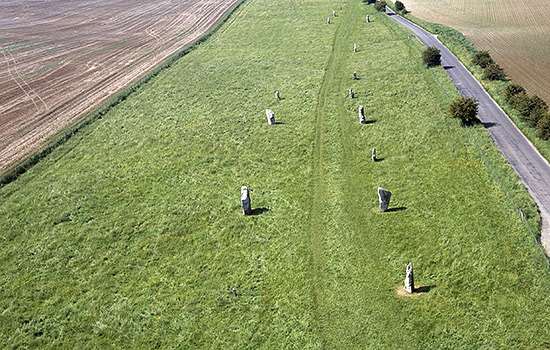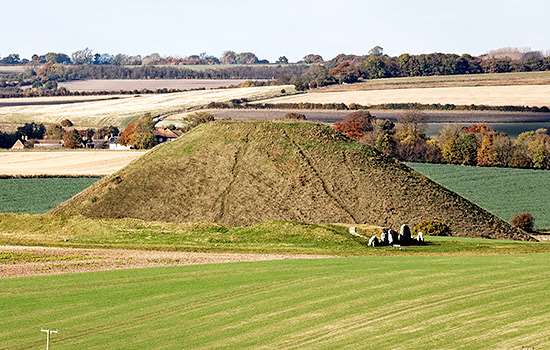Walking through Prehistory
You can visit most of the Avebury prehistoric sites for free, and walking between them gives a good sense of the whole landscape and how these monuments were connected to one another.
Join prehistorian Susan Greaney as she explores some of the lesser known monuments in the Avebury landscape, including the mysterious Silbury Hill, and West Kennet Long Barrow, where you can step inside one of Britain’s earliest built structures.
The first monuments
In the early Neolithic period, from about 4000 BC, early farming communities were settling in the Avebury area. Around 3670 BC, people worked together to build a huge enclosure on Windmill Hill, surrounded by three circuits of ditches. Archaeological finds from the ditches show that people gathered on the hilltop in large numbers – to take part in ceremonies or feasts, share news and exchange goods – and had long-distance connections.
Many long barrows were also built at this time. Some had stone chambers and were used as communal tombs, such as West Kennet Long Barrow, where at least 36 men, women and children were interred. Although burials took place there only over a short period, people continued to leave pottery, animal bones and domestic debris in the chambers long afterwards.
Circles of stone and earth
A second remarkable phase of construction began in the Avebury area in the centuries around 3000 BC. This was probably when the first enclosure at Avebury henge was built – a phase now hidden beneath the later earthworks – and possibly also the Cove, a setting of four stones that stood within it.
Over the next 500 years, a series of monuments were built and connected together to form an extraordinary complex. The bank and ditch at the henge were enlarged, and the largest stone circle in Britain – originally of about 100 stones – was erected inside. Within it were two smaller stone circles.
Two avenues, or parallel rows of stones, were built running southwards and westwards from Avebury – the Beckhampton Avenue and West Kennet Avenue. These may have been processional routes or links to other important sites or monuments. The West Kennet Avenue linked Avebury to the Sanctuary, a concentric timber and stone monument on Overton Hill.
Later changes
Meanwhile, in the valley below West Kennet Long Barrow, probably around 2500 BC, people built a complex of timber palisaded enclosures and monuments, which reveal evidence of intensive occupation and feasting. Nearby is the 30-metre high Silbury Hill, the largest prehistoric mound in Europe. Built in stages, using chalk dug from a surrounding ditch, it had reached its final form by about 2300 BC.
At this time, the entrance to West Kennet Long Barrow was closed with large blocking stones. This period also saw people in the Avebury area being buried with Beaker pottery, a style that had arrived with incomers from continental Europe. Often these burials were at the base of standing stones, as happened at the Sanctuary, and along West Kennet Avenue. In the early Bronze Age, about 150 round barrows – burial mounds for the dead – were constructed in the area.
Find out more
-

Alexander Keiller Museum, Avebury
The museum displays archaeological finds from the area, and information about the landscape. The Barn Gallery (National Trust) next door has interactive displays and a children’s area.
-

Explore the World Heritage Site
The best way to experience the Avebury World Heritage Site is on foot or by bike. Use English Heritage’s detailed archaeological map to help you plan your visit.
-

A Weekend in Wiltshire
Wiltshire may be renowned for its world-famous prehistoric monuments, but it also offers plenty of other intriguing historic places to visit on a weekend away.
-

Stonehenge and Avebury WHS website
The outstanding Stonehenge and Avebury Neolithic and Bronze Age landscapes became a World Heritage Site in 1986. Find out more on the WHS website.
-

Walking guides
A network of footpaths and bridleways cross the area, as well as some permissive paths and open access land. The National Trust website has a series of suggested walks.
-

Long Barrows and Broken Bones
We explore what the long barrows of the Cotswold Hills and Marlborough Downs reveal about burial practices and attitudes to death in the early Neolithic period.
-

Religion in Prehistory
What can be learn about what prehistoric people believed, using evidence from the monuments and artefacts that have survived?
-

England’s Prehistoric Monuments
England’s prehistoric monuments span almost four millennia. Discover what they were used for, how and when they were built, and where to find them.







